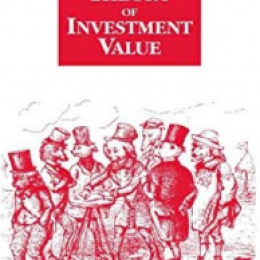Don’t expect unusual outcomes by acting in a usual fashion.
Buy the right company at the right price and leave it be.
“All of humanity’s problems stem from man’s inability to sit quietly in a room alone.” – Blaise Pascal, 1654.
When it comes to investing, we look to Bertrand Russel’s In Praise of Idleness. We believe one must have utter conviction in the strength of analysis and then leave it be. In the absence of material deviation from your analysis, leave your investments to mature as the laws of nature and physics demand. The progression of strategy and market has nothing to do with revolutions of the sun or the end of the financial year. It need not be linear either.
Difference in value calculation mechanics
In considering valuation, one should be aware that this is a subjective pursuit and that the mechanics of deriving valuation should be simple. We do not agree with mainstream investment methodologies that weigh heavily on estimations and assessments of risk unrelated to underlying business drivers.
However, as Einstein said, “Everything should be made as simple as possible, but no simpler.” There’s much more to valuing a company than a PE ratio. The financials, as displayed in annual reports, are in accordance with accounting requirements and conventions. They are a starting point for analysis, not conclusions in themselves. We rewrite the accounting for any business that we’re looking at. We use our standard approach to rebuilding financials to derive distributable earnings, which allows us to compare different business models under the one framework. The method has proven itself over many valuations in many different markets.
Intrinsic value is a subjective approximation. An item may be worth more to one who has specific knowledge over it and who attributes a greater potential for it in the future, than is recognised by another. It is that specific knowledge that will lead to markedly different results in valuation as it relates to those inputs in the calculation that require estimation. We believe modern investment theory becomes far removed from the underlying business situation with measures of risk not related to underlying business drivers and with too many inputs derived from estimations. Its users have succumbed to precision bias. In models involving multiple estimates over long time scales, the resulting calculation, whilst complex and laborious to derive, provides little insight. It simply leads the analyst to feel they have a correct answer having gone to such trouble in deriving it. In evaluating a useful model it must have as few inputs of estimation as possible. Those estimates necessary must be conservative to be as certain as possible. One must also be careful as to which business models they choose to make estimates on. When it comes to buying equity in businesses, one needs to pay a price that allows for error in valuation. One needs to find business models that have high degrees of probability in their outcomes as determined by the insight of the purchaser.
Perspectives on risk
Mainstream convention holds that risk is volatility and beta is a measure of that volatility. For us beta has no place in our assessment of risk. We have a long-term horizon, and short-term movements in the stock price are irrelevant to us. Movements of entire markets are not reflective of an individual company’s situation. Even the short-term movements of an individual stock price can vary wildly from the underlying business case. Why then should the short-term movements of a stock’s market price bear weighting on the valuation of the underlying company? It’s the dynamics of the underlying revenue drivers over a multi-year time horizon that represent our risk. We look at a business model and consider what it might look like in 10 years and what level of probability we can attribute to that future. It doesn’t matter to us if a small company has short-term volatility along its multiyear CAGR of 40%, as opposed to the perceived “less risky” company producing 5% growth per year. Conventional wisdom says the small cap is far riskier than the large cap. This thinking does not reconcile with us. Furthermore, from our point of view there can easily be more risk in the stable large cap then the fast-growing small cap. Aged business models are all undergoing some form of disruption. Consider banking. Convention wisdom will tell you that a young fintech growing revenue at 35% per annum with profitable cash flow from operations and taking market share is riskier than holding an established bank that is undergoing disruption and losing market share. Variance punishes downside and upside. For us, this makes no sense. We focus our thoughts on the fundamentals of the business model and the probability of acceptable returns over the long term. If the probability of acceptable returns looks high vs the probability of losing money, we make an investment. Beta is not linked to the underlying business fundamentals and has no use in our analysis.
Portfolio concentration demands exceptional analysis and that takes time
“It is trying to carry too many baskets that breaks most eggs in this country. He who carries three baskets must put one on his head, which is apt to tumble and trip him up. One fault of the American businessman is lack of concentration.” – Andrew Carnegie, 1885.
Quality analysis leads to high degrees of certainty. In theory, if you were certain a stock was going to rise 80% in the next 12 months and would continue to do so for the next 10 years, you would sell all of your worldly possessions and just own that stock, nothing else. However, the only thing certain is that we certainly can not know everything about anything. So we need some diversification, however, don’t let diversification increase your risk by insufficient analysis due to lack of time and bandwidth. Einstein said “It’s not that I’m so smart, it’s just that I stay with problems for longer.” I wager that you cannot adequately analyse and monitor 30 companies and their competitors. Further, I wager that if you were to rank those 30 companies in order of quality, the bottom 5 would not be justified in being in the portfolio when compared with the top 5 and they are in fact adding risk not subtracting it. Those that believe they need diversification to cover risk, as is the conventional wisdom, are better served by indexes. For investment success one must be truly passionate about doing it. Once the initial analysis is done, and the investment is made, it takes assiduity to maintain performance. All things are in constant flux, an irrational obsession builds a safe harbour.
Black swans, white swans, and very boring swans.
We can’t predict markets movements. We continually search for great businesses, with able management, selling at attractive prices. When we find an opportunity that matches our criteria we buy it. We pay no attention to macroeconomics or market forecasts and we don’t attempt to make our own. Markets can suddenly collapse, rocket upwards, or go nowhere for long periods of time without warning. When it comes to macroeconomics and the complexity of the interconnectedness of the world and all the actors in it, we don’t believe it is possible to make predictions. The media regularly identifies key individuals that predicted the last recession or market collapse. We must keep in mind that someone, somewhere, is always making predictions and creating logical arguments around them. The only certainty is that at some point a random event will align with someones logical reasoning for it.
The arithmetic of tax consequences favor the long-term investor.
- Starting Value $100,000.00
- CAGR 15%
- Tax on Sale 39% (income $90k to $180k inc. Medicare Levy)
- Short-term Investor sells holding at the end of each year.
- Long-term Investor sells holding twice over 10 years.
- Australian Taxation Law.
| Short-term Investor | Long-term Investor | |||||||||||
|---|---|---|---|---|---|---|---|---|---|---|---|---|
| Year | Accumulated Wealth | Annual Gain Before Tax | Tax Event On Sale | Realised Value | Year | Accumulated Wealth | Annual Gain Before Tax | Year End Value | Total Taxable Gain | Tax Event On Sale | Accumulation Year End / Realised Value | |
| 0 | $100,000.00 | $15,000.00 | $5,850.00 | $9150.00 | 0 | $100,000.00 | $15,000.00 | $0 | $15,000.00 | |||
| 1 | $109,150.00 | $16,372.50 | $6,385.28 | $9150.00 | 1 | $115,000.00 | $17,250.00 | $0 | $17,250.00 | |||
| 2 | $119,137.23 | $17,870.58 | $6,969.53 | $9150.00 | 2 | $132,250.00 | $19,837.50 | $0 | $19,837.50 | |||
| 3 | $130,038.28 | $19,505.74 | $7,607.24 | $9150.00 | 3 | $152,087.50 | $22,813.13 | $0 | $22,813.13 | |||
| 4 | $141,936.78 | $21,290.52 | $8,303.30 | $9150.00 | 4 | $174,900.63 | $26,235.09 | $0 | $26,235.09 | |||
| 5 | $154,924.00 | $23,238.60 | $9,063.05 | $9150.00 | 5 | $201,135.72 | $30,170.36 | $231,306.08 | $131,306.08 | $31,487.90 | -$1,317.55 | |
| 6 | $169,099.55 | $25,364.93 | $9,892.32 | $9150.00 | 6 | $199,818.17 | $29,972.73 | $0 | $29,972.73 | |||
| 7 | $184,572.15 | $27,685.82 | $10,797.47 | $9150.00 | 6 | $229,790.90 | $34,468.63 | $0 | $34,468.63 | |||
| 8 | $201,460.51 | $30,219.08 | $11,785.44 | $9150.00 | 8 | $264,259.53 | $39,638.93 | $0 | $39,638.93 | |||
| 9 | $219,894.14 | $32,984.12 | $12,863.81 | $9150.00 | 9 | $303,898.46 | $45,584.77 | $0 | $45,584.77 | |||
| 10 | $240,014.46 | $36,002.17 | $14,040.85 | $9150.00 | 10 | $349,483.23 | $52,422.48 | $401,905.72 | $202,087.54 | $49,629.46 | $2,793.03 | |
| Ending Value Yr 10 | $261,975.78 | Ending Value Yr 10 | $352,276.26 | |||||||||
The long-term investor is better off by 34.7%.
Selection process of new hires, a radical approach.
We don’t look to the most prestigious universities or big names on resumes. In fact we don’t pay much attention to resumes at all. Our way of thinking about investing is different and so we teach new recruits our methodologies ourselves rather than outsource that education to a university or leverage off their prior experience. With this being the case, we don’t need to hire employees with finance backgrounds. In fact to avoid ingrained biases, it makes little sense to do so. We gain more from their unique knowledge in other areas. We have codified the mechanics of our financial analysis.. We look for energetic, super smart, creative people with specific knowledge different to our own, and a hunger to learn. With that, we follow the onboarding process below.
1. Selection for intelligence from a large sample size.
We leverage genetic variation in populations lacking opportunity. Minimum sample size is 1,000. These people are graded on intelligence by taking an online exam as the first filter. The exam includes over 40 questions including mathematics, reading and comprehension, and critical reasoning. The questions are derived from the Medical Entry Exam and are very good at assessing a person’s natural intelligence with the least amount of influence from previous education. There is also a short essay component designed to allow the applicant to express areas of their specific knowledge and ability to communicate. Data from previous hires has shown minimum scores required to perform well in the role.
2. Alignment.
After selecting candidates meeting minimum thresholds from the above sample size, we then filter for alignment. We take cues from the applicants essay, CV, cover letter. Applicants meeting those requirements are then directed to take the Myers & Briggs MBTI personality assessment. We use those results to confirm alignment to our requirement and preference desirable personality types we don’t currently have in the team.
3. Communication skills and an analytical mind.
It’s critical the applicant is a good communicator. We conduct a skype interview and assess the quality of dialog through conversation around the applicants specific and general knowledge. We also conduct a case study to evaluate the applicant’s ability to make well-formed assumptions in calculating the breakeven point of a small business with limited available data. They must make a series of sensible assumptions and be able to justify their reasoning.
4. Performs in our environment.
The nature of our work environment requires team members to be able to perform independently and often alone. They must possess the talent and drive to ask questions and form answers themselves. To self-direct, learn, and discover. We have developed a number of tools and manuals that guide to our procedures and reasoning but to deliver real benefit a team member must be able to develop their own viable investment thesis utilising the application of their own knowledge, research, and conclusions.
Inspired by these great thinkers
You must decide for yourself what is true. Learn from others to develop knowledge, use that knowledge with your creativity to find your own truth.










